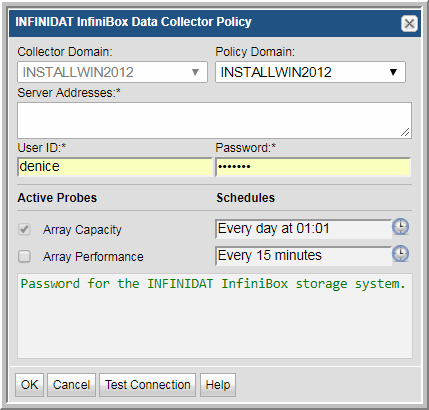.


Field | Description |
Collector Domain | The domain of the collector to which the collector backup policy is being added. This is a read-only field. By default, the domain for a new policy will be the same as the domain for the collector. This field is set when you add a collector. |
Policy Domain | The Policy Domain is the domain of the policy that is being configured for the Data Collector. The Policy Domain must be set to the same value as the Collector Domain. The domain identifies the top level of your host group hierarchy. All newly discovered hosts are added to the root host group associated with the Policy Domain. Typically, only one Policy Domain will be available in the drop-down list. If you are a Managed Services Provider, each of your customers will have a unique domain with its own host group hierarchy. To find your Domain name, click your login name and select My Profile from the menu. Your Domain name is displayed in your profile settings. |
Server Addresses* | One or more InfiniBox Server IP addresses or host names to probe. Comma-separated addresses or IP ranges are supported, for example 192.168.0.1-250, 192.168.1.10, myhost |
User ID* | View-only User ID for the INFINIDAT InfiniBox storage system. |
Password* | Password for the INFINIDAT InfiniBox storage system. The password associated with the User ID. |
Array Capacity | This collection is enabled by default to collect array capacity data from your INFINIDAT InfiniBox environment. |
Array Performance | Select to collect real-time performance information for INFINIDAT InfiniBox storage system. To avoid data loss, it is recommended to set a collection schedule for no more than 25 minutes. |
Test Connection | Test Connection initiates a Data Collector process that attempts to connect to the subsystem using the IP addresses and credentials supplied in the policy. This validation process returns either a success message or a list of specific connection errors. Test Connection requires that Agent Services are running. Several factors affect the response time of the validation request, causing some requests to take longer than others. For example, there could be a delay when connecting to the subsystem. Likewise, there could be a delay when getting the response, due to other processing threads running on the Data Collector. You can also test the collection of data using the Run functionality available in Admin>Data Collection>Collector Administration. This On-Demand data collection run initiates a high-level check of the installation at the individual policy level, including a check for the domain, host group, URL, Data Collector policy and database connectivity. You can also select individual probes and servers to test the collection run. See Working with On-Demand Data Collection for details. |